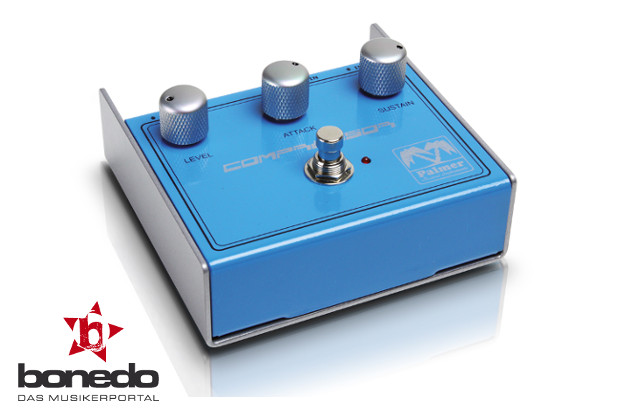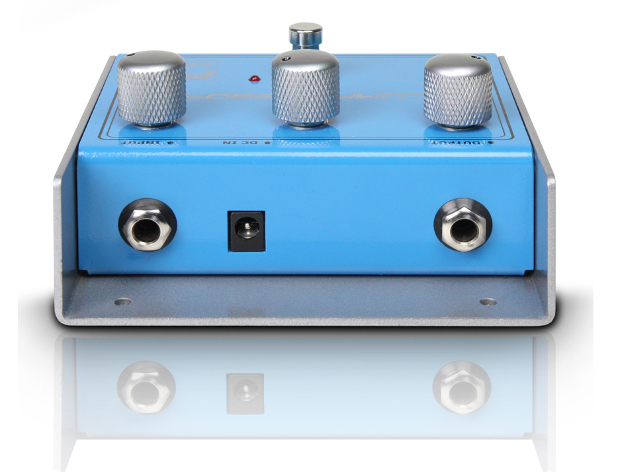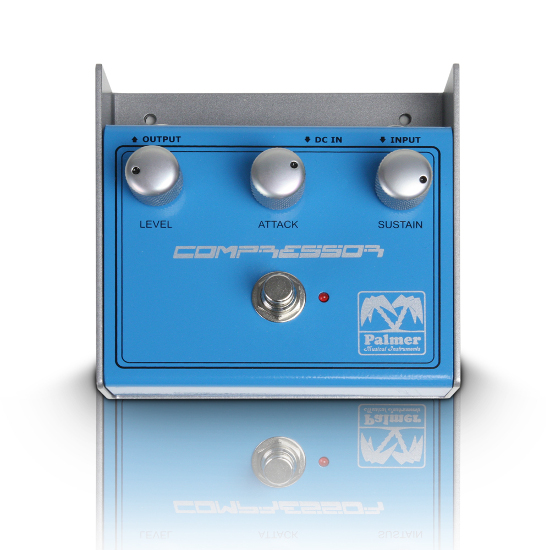Palmer Root Effect compressor – I like blue – test report from Bonedo.de
Our third test candidate from the range of Palmer Root Effects is blue and operates as a compressor. When it comes to dynamic processing, the tastes of guitarists are well-known to vary widely. Some like hard compression á la MXR Dynacomp, a legendary pedal which interferes strongly with the sound pattern, others prefer compressors which work subtly and whose effects one feels more than hears. The following tests lets you know in which category the Palmer falls.

Casing/look
All Palmer Root Effects come in uniform casings with identical outside measurements (120 x 95 x 56 mm). The cover consists of two U-shaped curved steel sheets (2 mm thick), which are nested together and painted different colours. The underside and two sides are finished in grey for all Root Effects, with the top painted in a colour according to the effect – for compressors it is blue. The complete underside has thick rubber glued to it, so that the pedal does not slip on the ground.
This is also where the pivoting battery compartment is found, which makes quick and easy battery changes possible because the 9 V block battery only needs to be placed in the compartment. When the lid is closed the connectors are pressed on the contacts and the device is supplied with electricity. No placement on small contact surfaces or fiddly extraction of the battery from a tight compartment is necessary.
Another practical feature on the underside of the casing is two holes, which mean the pedal can be screwed onto an effect board. Also practical is the protruding lower part which, along with the high side walls, protects the connections on the back from environmental influences. The usage of cables with angled connectors is hardly possible with the effect board, unless they are aimed upward. This means that the connector is much less likely to be snapped off the socket due to a careless step.
The metal controllers placed on the top are arranged in a line. They are painted grey, come with a drilled point for marking the position and are relatively stiff when compared to guitar potentiometers. This makes a lot of sense; after all, they shouldn’t move because of just any gentle contact. Underneath the controller is the foot switch, which works without any glitches. Next to the switch is a small red LED which displays the effect status, and is lit up when the effect is switched on.
Overall, the pedal gives the impression of being high-quality and completely roadworthy.
Back/connections
There are three sockets for connectors on the back: Double jack for input and output, and standard DC port for the power cord, which, as is standard with small pedals, is not included in delivery. Standard effect power cords from Boss or Ibanez can be used.

Operation
There are controllers to manage the effects for Level, Attack and Sustain. But before you start intuitively twiddling them you should first understand the function of a compressor and its adjustable parameters.
So: a compressor primarily serves to raise quiet signals and mute loud signals. With the Attack controller you can set the point at which the compressor starts working; this is also known as the “response time”. If the controller is turned to the left the wait is very short; if it is turned up, then it takes longer for the compressor to kick in. Sustain controls the dynamic limit. Maximum compression is achieved with a fully turned up controller. How this affects the guitar signal can be seen in the “Practice” section. Lastly, there is the Level controller, which sets the total volume of the signal.
Practice
Experience has taught us that all compressors on the market react differently. In order to guarantee that we began our testing as “neutral” as possible, we initially set all controllers to 12 o’clock.
Compared to Overdrive or other effects, a compressor generally works subtly – you can hear it at work, but not always immediately. In order to present everything as clearly as possible, I recorded a number of audio samples, both with and without the effect (labelled with the ending “NFX”) and then with the compressor turned on. This lets you compare. With a cleanly adjusted amp and the 12 o’clock setting, the pedal sounds like this: go to the audio sample here
In this setting, there is already a higher level with an activated compressor. The quiet tones are gently lifted, the loud ones somewhat reduced. Because the tones come across more strongly, and also last longer, the entire feeling ends up being somehow more relaxed. However, with the Sustain setting at more than 12 o’clock, there is already a light pump effect heard when the chords fade. You clearly hear the delayed entry of the compressor, an effect which is made even more intense with the fading of a chord. But don’t panic; this is just the first stock take, to see in which direction we’re heading. There is nothing to complain about with the sound quality. The sound stays relatively neutral, the bass and trebles are slightly raised.
Functioning of the Attack controller
Now we examine the adjustment possibilities of the Attack controller. To do so, I struck a chord three times in a row, and let it fade out. We start with a minimal Attack value (the compressor starts immediately), then a medium value (12 o’clock) and finally turn it up to the maximum (now the compressor is applied very late – approx. 100 ms). The range of options means that the effect which suits the respective use can be precisely set.
Effect of the Sustain controller
Here another field is examined. If the Sustain controller is set to the minimum value, you receive almost no compression, the sound simply gets a little thicker. Many guitarists like to use this setting as a boost function. If your personal taste is to turn up the level a little higher, then you achieve a stronger solo sound. In the medium setting, the compression behaviour is still natural, but gets more and more intense. When turned up to full, you no longer heard the hard start, everything is sealed off. In principle this isn’t bad, but it depends on how it is being used and the respective setting. You can – but you don’t have to … here are four examples, once without the compressor and then with three different Sustain settings.
Clean sound picking – strumming
With cleanly set sounds, you can easily adjust small differences in sound levels with the Palmer compressor (such as different sound levels caused by different types of playing). For example, if in one song you first strum with your fingers and then later with the pick, then the finger playing is generally too quiet. And if you turn up the amp, the hard stroke with the pick pops so loudly that it rings in the ears. With the Palmer compressor this problem can be controlled in a more natural sounding way. With Attack on minimum and Sustain at 1 o’clock you achieve a satisfactory sound. The sound is slightly altered with the compressor turned on, but this is the typical sound. The slightly raised treble makes everything sound a little fresher. To make comparison easier, the riff is played here once with and once without the effect.
“Artificial Sustain”
The next task is to give a somewhat weak guitar a stronger tone. To achieve this, the Attack controller is set to a longer settling time. This retains the original stroke, and the signal is lifted up so that it continues strongly. In this area, the Palmer compressor sounds very natural. It doesn’t make an artificial Sustain out of a naturally somewhat weaker sound, but raises the fading tone up a little while letting it fade smoothly. Funky sound with ghost notes Now we want to bring the ghost notes in a funk groove forward a little. This also works well, though with a high Sustain setting and hard strokes on the guitar you notice that the sound quality weakens slightly.
Overdrive
In Overdrive operation you feel a more subtle intervention in the sound, and compared to other compressor pedals, the sound remains relatively stable with the Palmer pedal. The distortion of the amp simply becomes a little denser and more compact with the compressor.

Conclusion
The Palmer compressor was very impressive. It is a more subtle type of agent, and creates a compression that doesn’t lose much of the sound with normal settings. The device doesn’t create extreme compressor sounds. And generally we don’t want that. In general a guitarist wants to retain the sound and character of the instrument and amp, while making a couple of subtle dynamic corrections. The Palmer compressor does this very reliably. The setting options, from mild to hard compression, permit varied sound design. The pedal is also robustly constructed, so that a long life and reliable use on the stage is guaranteed. It is very good value for money.
Pro
+ Robust construction, absolutely roadworthy
+ 5-year manufacturer’s warranty
+ Good compression
+ Subtle effect on the sound
Con
–
Facts
Manufacturer: Palmer
Model: compressor
Type: compressor pedal
Controllers: Level, Attack, Sustain
Connections: input, output, DC 9V
Power consumption: approx. 12 mA
Size: 120 x 95 x 56 (W x D x H) mm
_____________________________________
Source: Bonedo.de : http://www.bonedo.de/artikel/einzelansicht/palmer-root-effect-pecomp-compressor.html
Author: Thomas Dill
Learn more about the Palmer Root Effects Compressor here:
http://www.palmer-germany.com/mi/en/COMPRESSOR-Compressor-effect-for-guitar-PECOMP.htm
Leave a Comment
You must be logged in to post a comment.











